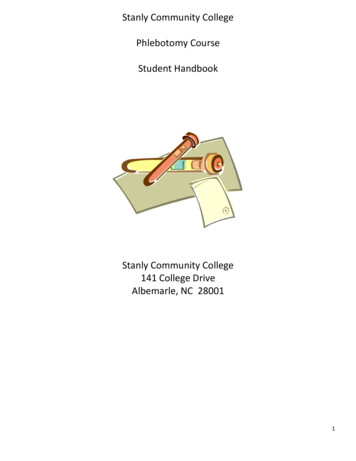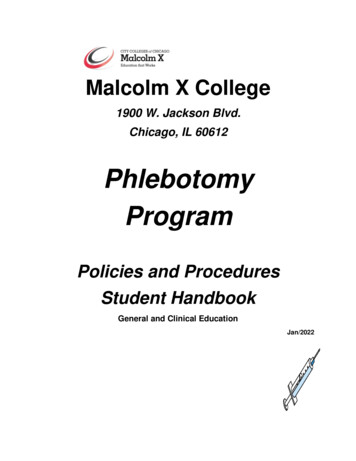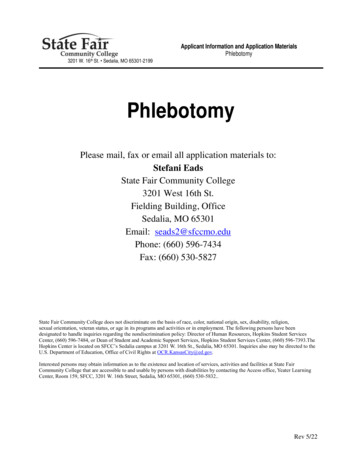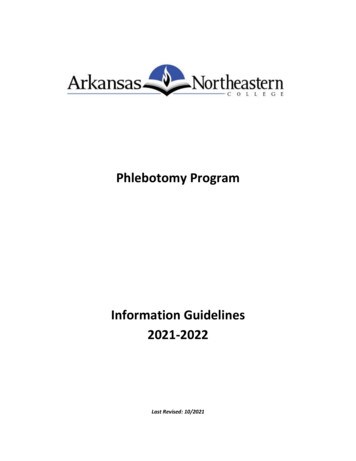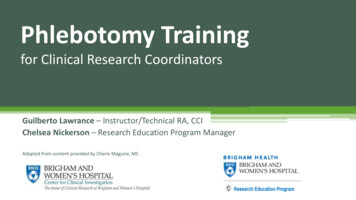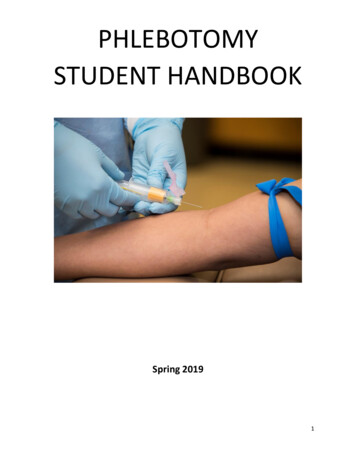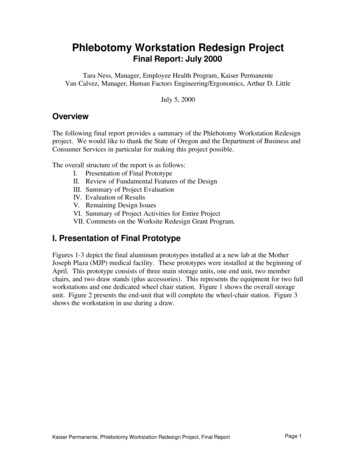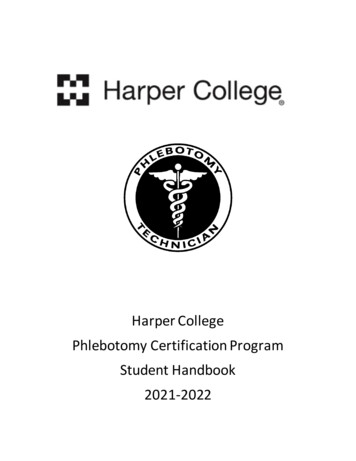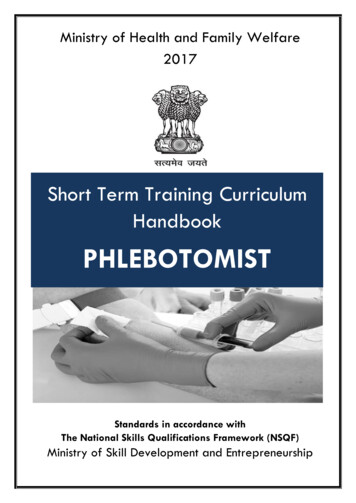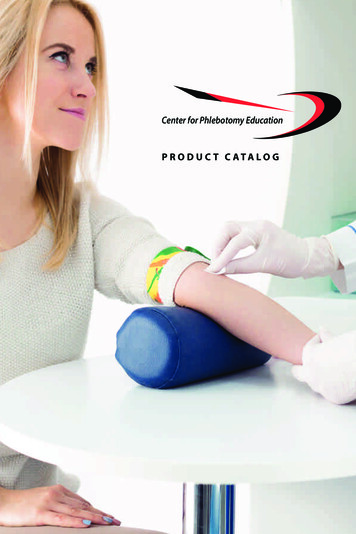
Transcription
Center for Phlebotomy EducationP R O D U C T C ATA L O G
It is our mission to empower those whoperform, teach, and manage bloodcollection procedures for clinical testingto do so with professionalism, integrity,precision and compliance.2Center for Phlebotomy Education
A message from our Director:Do you teach phlebotomy?Do you perform venipunctures and skin punctures?Do you manage blood collection personnel?Then we work for you.Dennis J. Ernst MT(ASCP)Since leaving my full time position in the lab in1998, I haven’t worked a day in my life. That’sbecause what my team and I do at the Center forPhlebotomy Education is too enjoyable to be called“work.” Because we interact with you on so manylevels, we know your wants, needs and problems.That’s not work; that’s a calling. We respond bycreating.Not a year goes by that we don’t find new problems of our customers that needour creativity to help solve, or a new way to resolve your lingering problems thatrequires an innovative approach. For example, since our last catalog came out, we’vecreated six new DVDs (page 5), enhanced almost a dozen existing products, eventsand documents, eliminated shipping fees on domestic orders over 50 and reducedpricing on Phlebotomy Channel subscriptions (page 6). Our popular Boot Camps(page 17) have empowered hundreds of managers and educators from around theworld on how to turn their staff and students into high-powered talent.When I’m not lecturing at a conference, I’m coordinating the creation of solutionsto your problems. In between, I’m answering questions by email and phone fromhealthcare professionals just like you with questions they can’t answer and problemsthey can’t solve. Put our number on speed dial. 866.657.9857. Don’t be surprisedif I answer the phone. If my staff is tied up with other customers, you won’t gettransferred to voice mail if I can help it.My staff and I spend our days listening, creating, and empowering. In the pages thatfollow, we hope you’ll find something that solves a problem for you. If not, let usknow. You’ll likely see it in our next catalog.Respectfully,Dennis J. Ernst MT(ASCP)DirectorListening. Creating.Empowering.phlebotomy.comtoll free:1-866-657-98573
Applied Phlebotomy Training VideosBasic VenipunctureDVDsLearn the basic technique for drawing blood samples by venipuncture according to theCLSI standards. Detailed demonstrations include performing venipunctures using tubeholders, syringes and winged blood-collection sets. CE questions available for in-houseCE programs or for requesting P.A.C.E. credit. (Runnin g time: 30 minutes.)Item #6020 299.99 2 .00Preventing Preanalytical ErrorsOver 40 errors that collectors can introduce into specimens during collection,transportation, and storage that alter test results are detailed in this video. CE questionsavailable for in-house CE programs or for requesting P.A.C.E. credit. (Running time: 39minutes.)Item #6021 – 259.00Avoiding Phlebotomy-Related LawsuitsThis video identifies the types of injuries patients suffer from poorly performedvenipunctures that can lead to legal action against those who draw blood specimensand their employers, using actual case studies from the files of an expert witness. CEquestions available for in-house CE programs or for requesting P.A.C.E. credit. (Runningtime: 36 minutes.)Item #6022 – 259.00Skin Punctures & Newborn ScreensThis video demonstrates the proper technique for performing fingersticks, heelsticks, andnewborn screening collections, based on the latest CLSI standards and OSHA guidelines.CE questions available for in-house CE programs or for requesting P.A.C.E. credit.(Running time: 32 minutes.)Item #6024 – 259.00Arterial Blood Gas CollectionThis video covers the critical aspects of arterial sampling every respiratory therapist,phlebotomist, nurse, and physician must know when collecting arterial blood gases.The procedure reflects the guidelines and standards of the American Associationfor Respiratory Care (AARC) and the Clinical and Laboratory Standards Institute. CEquestions available for in-house CE programs or for requesting P.A.C.E. credit. (Runningtime: 29 minutes.)Item #6026 – 125.00For quantity discounts and discounts on multiple titles, contact us.4Center for Phlebotomy Education
Lecture CollectionDennis Ernst’s most popular lectures,filmed and produced in our studiofor your training libraryPotassium Results Your Physicians Can TrustDVDsThis video discusses the multitude of ways potassium results can be altered during collectionor processing leading physicians to question results. Some contributors include fist pumping,improper centrifugation, delays in processing, prolonged tourniquet constriction, anincorrect order of draw, drawing through certain IV canulas, hemolysis, iodine as a site prepsolution, patient-dependent variables, and more. (Running time: 43 minutes.)Item #6035 --- 149.00– .00Delivering World-Class Customer ServiceThis presentation discusses key concepts in customer service excellence. Emphasis is placedon telephone etiquette, behaviors that reflect and detract from professionalism, positivepatient interactions, and dealing with difficult/demanding patients and co-workers.The presentation concludes with a discussion on how managers can inspire a culture ofcustomer service excellence. (Running time: 37 minutes.)Item #6031 --- 149.00 .00Successful Strategies for Difficult DrawsAmong the most challenging situations healthcare professionals face when drawingblood samples are draws from geriatric, oncology, pediatric, neonatal, obese, cognitivelyimpaired, and intensive-care patients. This presentation discusses strategies to successfullyobtain blood under a wide variety of difficult circumstances. (Running time: 38 minutes.)Item #6032 --- 149.00 .00Ending Hemolysis in the ED. and Everywhere ElseThis video discusses the cost and causes of sample hemolysis, details how laboratories canprevent its occurrence in the emergency department and throughout the facility, providesbenchmarks for comparison with other facilities, and presents effective strategies managerscan implement to reduce sample rejection due to hemolysis facility-wide.(Running time: 46 minutes.)Item #6028 --- 149.00 .00Seizing Control of Blood Culture Contamination RatesOn average, treating patients for false-positive blood cultures cost hospitals 5000 inunnecessary antibiotic therapy and laboratory tests. It also extends the patient’s hospitalstay 3.3 days. This video discusses the most common causes of blood culture contaminationand strategies to reduce it in your facility, even where phlebotomy services have beendecentralized. (Running time: 43 minutes.)Item #6038 --- 149.00 .00Mastering Pediatric PhlebotomyThe equipment and techniques required to obtain high-quality specimens from pediatricpatients are discussed in this video. Topics include site considerations for infantsand toddlers, skin-puncture safety, age-specific considerations, maximum volumeconsiderations, proven strategies to calm anxious children, and a literature summary ofpain reduction products and techniques. (Running time: 47 minutes.)Item #6029 --- 149.00 .00phlebotomy.comtoll free: 1-866-657-98575
Streaming VideoPhlebotomy ChannelNow you can provide your staff or students the industry’s most popular phlebotomy videos &lectures from any computer, anytime, anywhere.The Phlebotomy Channel is your portal to streaming videos, webinars, and lectures by theworld’s most trusted source of accurate information on blood specimen collection. Online, ondemand, and on the mark.nA growing library of phlebotomy videos;nView content 24/7 from any computer with a high-speed Internet connection;nNo need to track down borrowed DVDs;nNo need to involve your IT department;nContent regularly updated as standards evolve.nOnline CE quizzes for each video means immediate assessment of comprehension.nA complete viewing history of who’s watched what videos, and when.Pricing:All Access Pass (facility-wide): 1299/year (Item#4400) 99/year (Item #4400)Annual subscription (facility-wide): 199.00/title 99/titleOne-time viewing: 39.99/title6Center for Phlebotomy Education
Streaming VideoTitles currently available:Applied Phlebotomy training videosnBasic VenipuncturenPreventing Preanalytical ErrorsnAvoiding Phlebotomy-Related LawsuitsnSkin Punctures & Newborn ScreensnArterial Blood Gas CollectionnManaging the Risks of Patient InjurynMastering Pediatric PhlebotomynPotassium Results Your Physicians Can TrustnSuccessful Strategies for Difficult DrawsnSafety Survey: How Vulnerable Are You to a Needlestick?nSeizing Control of Blood Culture Contamination RatesnEnding Hemolysis in the ED. and Everywhere ElseFor more information and full previews of all titles,visit www.phlebotomy.com/PCTV.cpe or call 866-657-9857.phlebotomy.comtoll free: 1-866-657-98577
Phlebotomy Central MembershipOur On-line Knowledge BaseFEATURES:nnnnPhlebotomy Central MembershipItem #4081 99.00 (access for up to 50 staff/students)The most exhaustive body of specimencollection information ever assembled;24/7 access to articles, newsletterarchives, FAQs, and management tools;Searchable by keyword;Updated regularly.Includes:nnnnnphlebotomy.comtoll free: 1-866-657-9857MembershipsnArchives – All issues of Phlebotomy Today since 2000;To The Point – Over 20 articles in PDF format on a wide variety of specimen collection topics.(See page 10 for a complete list.)FAQs – Answers to hundreds of the most frequently asked questions on blood sample collection;Manager’s Toolbox – A compendium of SmartCharts, templates, and other documentsmanagers and educators can use to enhance their understanding of preanalytical physiologyand manage their staff more effectively;ATMs – Short articles on a wide variety of topics for distribution to your staff or students toreinforce your training and help you meet your monthly CE requirements. Each article comeswith an answer key.To the Point in-house CE Booklets – PDFs of our downloads on Page 12.8
DownloadsTo the Point. Articles in Phlebotomy25 articles on a wide variety of topics.Titles currently available: Difficult Draws Drawing Under Special Conditions Handling Patients with NeedlePhobia How Phlebotomists Can AlterPotassium Results How to Become a BetterPhlebotomist, Part 1 How to Become a BetterPhlebotomist, Part 2 Mastering Pediatric Phlebotomy OSHA Update Pediatric Pointers Phlebotomy’s Best-Kept Secret: TheOrder of Draw Preanalytical Errors that Occur AfterCollection Preanalytical Trilogy Risks to Phlebotomists: Allergies,Ergonomics, & Needlesticks See You In Court! Assessing YourVulnerability to a PhlebotomyRelated Lawsuit What Every Phlebotomist MUSTKnow! What Every Phlebotomist MUSTKnow About Hand Hygiene When Professionals Aren’t:Behaviors that Create BadImpressions If Tubes Could Talk Preanalytical Errors that OccurBefore Collection Reducing Pain During Infant andPediatric Venipuncture Preanalytical Errors that OccurDuring Collection Collection Protection Eight Questions Everyone WhoDraws Blood MUST AnswerCorrectly Ergonomics From thePhlebotomist’s Perspective Garbage In/Garbage OutArticle descriptions and pricing available online at www.phlebotomy.com under “downloads”.Access to these articles is free to Phlebotomy Central Members. (See page 8.)9Center for Phlebotomy Education
Venipuncture TutorDownloadsA step-by-step guide to performing venipunctures using asyringe, tube holder and winged blood-collection (butterfly) set.(8037 words,17 pages, 29 illustrations)Item #6400 29.99Blood Specimen Collection by VenipunctureDocument # /Version #Effective Dat e: mm/dd/yyBlood Specimen Collection by VenipuncturePurposeThis procedure provides instructions for collecting patient blood samples by venipuncture, according to the currentstandard of care for phlebotomy as established by the Clinical and Laboratory Standards Institute (CLSI). When propertechniques for blood specimen collection are followed, the risks of preanalytic errors and injury to patients and/oremployees are reduced.MaterialsStock collection areas and trays with sufficient quantities in a manner that protects the integrity of the items and provideseasy access. Monitor expiration dates of supplies, as appropriate. [Note to user: Below is a table of supplies andequipment most commonly used. Edit this table according to the specific supplies and equipment your facility uses.]Venipuncture Procedure TemplateSupplies and Equipment Safety needles of various lengths and gauges70% isopropyl alcohol prep pads or other skindisinfectant Single-use tube holder adaptersGauze pads Safety winged collection setsLatex-free disposable tourniquets Sterile syringes of various sizesLatex-free bandages or tape Safety transfer devicesLatex-free gloves Collection tubes of various types and sizesOther personal protective equipment, as required Blood pressure cuff (if used in place of a tourniquet)Sharps containerWritten in CLSI’s recommended format for a laboratory procedure, thiseditable Microsoft Word document contains the provisions of the lateststandard your current procedure may be missing. Simply download it andcustomize it for your facility. (14 page download)Healthcare personnel should have an assortment of venipuncture supplies and equipment within reach when drawingblood specimens. Ensure the integrity and quality of all supplies and equipment before use. Dropped items should not beused on a patient even if sterility has not been compromised, due to the perception of contamination to the patient.Because the undersides of phlebotomy trays carry a host of bacteria, avoid placing phlebotomy trays on inpatient surfacessuch as bedside trays and night stands. Never place a phlebotomy tray on the patient’s bed.Approaching the PatientFollow the activities below to properly approach hospitalized patients. For outpatients, follow the same procedure,beginning with Step 3.Facility’s Name, Your City, Your State[filename and path]Item #6402 49.99Blood Specimen Collection by Skin PunctureDocument # /Version #Effective Date: mm/dd/yyBlood Specimen Collection by Skin PuncturePage 2 of 14PurposeThis procedure provides instructions for collecting patient blood samples by capillary puncture, according to the currentstandard of care for phlebotomy as established by the Clinical and Laboratory Standards Institute (CLSI). Obtainingblood by skin puncture may be an alternative to venipuncture for patients in whom venous access is difficult, and whensmall quantities of blood are sufficient for testing. In comparison to venipuncture, capillary collections pose fewer risksto patients. When proper techniques for blood specimen collection are followed, the risks of preanalytic errors and injuryto patients and/or employees are reduced.Skin Puncture Procedure TemplateWritten in CLSI’s recommended format for a laboratory procedure, thiseditable Microsoft Word document contains the provisions of the CLSIstandard H4-A6 your current procedure may be missing. Simply download itand customize it for your facility. (8 page download)Item #6403 49.99SmartCharts Blood Sample Collections During IV Starts(6-page download) – Item # 6405, 19.99Blood-Collection Errors and Their Impact on Patients(2-page download) – Item # 6415, 19.99 Supplies and Equipment70% isopropyl alcohol prep pads or other skin Commercial heel warmer or warm compressdisinfectant Safety puncture or incision devices of various depthsGauze pads Micro-collection containersLatex-free bandages or tape Plastic or mylar-coated microhematocrit tubes andLatex-free glovessealantOther personal protective equipment, as required Newborn screening formsSharps container Point-of-care (POC) testing supplies and equipmentHealthcare personnel should have an assortment of supplies and equipment within reach when collecting capillary bloodspecimens. Ensure the integrity and quality of all supplies and equipment before use. Dropped items should not be usedon a patient even if sterility has not been compromised, due to the perception of contamination to the patient. Becausethe undersides of phlebotomy trays carry a host of bacteria, avoid placing phlebotomy trays on inpatient surfaces such asbedside trays and night stands. Place phlebotomy trays on the floor, windowsill or on bedside wastebaskets. Never placea phlebotomy tray on the patient’s bed.Observe Standard PrecautionsDefined by the Centers for Disease Control and Prevention (CDC) and OSHA “Standard Precautions” is a method ofinfection control in which all blood and certain body fluids are treated as infectious for HIV, HBV, and other bloodbornepathogens.Step1ActionExercise Standard Precautions.If the patient is on isolation Then [Note to user: insert your facility’s policy herefor gloving, gowning, etc., when drawing fromisolation patients.] Note to user: insert your nursery’s policy herefor gloving, gowning, etc., when drawingnewborns and infants.]entering the nurseryApproaching the PatientFollow the activities below to properly approach hospitalized patients. For outpatients, follow the same procedure,beginning with Step 3.Center for PhlebotomyEducation’sPage 2 of 8Collecting BloodSamplesDuring IVStartsCenterTo prevent hemolyfor Phlesis botomy perfoEducatiorm venipunctures whenevWhen notn’ser possible.possible:Investiga Draw onlyfrom large-bore cannulas (i.e. Avoid line14draws throughTeflon or Vialon 16 gauge). Minimizeduration of tourniquecatheters.How to Uset constriction.a syringe insteadcan falseuse this charof ao t: ThisCenter tube holder assembly:thechartsmallestthe comp ly elevate testuseinclusyringeo breakfor knowresultheanion checdests. PhysPhlpossible;seal icianonn preaeboplungerEdtheo klist(pagestomassurebeforenalytsucaanda tightical causy use;tionclinicconnectioto rule’sn al laboro slowly pull4-5) lueres oftheatoriesyringe;back onor rule withtheinsyringes expe elevated potasoutplunger;theseBloriencingdependoo fill tubes immediately usingknowodnSpquestionasium levels, inclua safety transferentanglecontreciibutovaritubeble potasdingthe blood impactsdevice;menrs.ablesoForo allow thesium resul those thatsMyeloproagainstHandtube's vacuumthe side Common tiveof tube,ts canDo not submitlingnotleukocytosliferabottom;usedisorder, samples obtained to pull blood into the tube.DiaTo avoid underfignostic & Procesis 1-4leukeby sluggish draws.CommenTubeslling mias, thromLabora sing Gu fill all tubestsRenal /-10% ofcontainbocyidetoryCe,nttosisfailur 6theiring addIf theTests 1,2,3 linesstateder fo HypevolumeAdrenoco e Reject all underfilled tubes.tubitivrkalerat eesrtical hypomia obse sod theconKeep smaller-vbedside EdPhlebshocounDiabetes 6recollecttainsanducrved int. 5 Serufunction 6 olume tubesium citrarm'sthe sample. Whenotpatiem potasbeatiuldomblood culture an within100,0genFear/anxion00ate asreach fordifficultytly sium eleva nts with 600sampleincreadd’sdraws.volumeset, 7submit atety/phobiaaseisinvitive inadequa,000the addtes 0.15in plateleast onenoproperlyDehydratio 5,8 dividingte to fill both bottlesert letothermmol/L plateletantico filledcounin edaerobicaft t. 5the sampleNotthanbottleitivfor everye:equallyTo avoid additiveExercise nagulanfore testing rather onebetweenThen er collecsodiumtwot orerroneoShakingthanbottles.tio fill tubes incitraten tocarryover Familial pseuus res or vigorou clottin invOnethe propermixgultsdohyinversio1. Bloodthe tubperkalemiaof .draw:Propers mixing activatorthe top ordercultures inv ert the tub7ne’s conmixing of tubes2. Citrate tubee3before is defineert thetents.require can cau noupendi d as upetube – 4 times.3. Serum tubeIntra-indivinvs gen5 – 10seng aga PotaTubesndissiumidual4.variang theelevatle by hemolys ersionsHeparinin.Passive,tion tube shouldare req times.tube ted comis anduppletoroomte 0.95. EDTA tube180Stab-temcells into/orbe kepinvemmoDrug/chuired.Ifperadegrsio l/L. 9 platurereeleakailityemi6.t cloALsedstanding serums, thege ns, not telet clum/plascalOxalateBUinterfertube theof potas justof unse bema.pingretuALT MIandforePotassiumn dein persoan ANspecNote: If multiple esasesituponstoppen’s ALuprigh k-and-fort activationALDOmonths. 5 upntri.(For ceimensyringes are filled,rigpotasAminsiumt. Allo, leah tiltinhtYTis remSTERservarycanfuEevacuateaPrTTpoTo avoid mixing Angioocaproic acidorder in which theywumthemthe air g of the ding towere drawn.intooveup togatioIndomONthe tubes in thesitionsamtensin-converrors dE (EDethacaPTTbubble tube.same throu ples 7.7%nover(ACE)erting yThIsoniazid ininhibi gentlghouunles andthreemixe tubesenzym(patieento riseTAAM theas soon as filled.Antineopla tors sestplaYLtraothLithiutontpasma) anaCitrate tubes: m tubeASE All onnsperwAMhaveratio3-5ortiseArginine stic agentsun beengentle is cenYLstoMannlyte con All otherindicaitolpper inversions. ASE interfere fractionknown toBICRO andtrifutubes:pro n from 5-10β-adrenergwith testinARged(hepaMethgentle inversionatedg. 8,10 elevaote e.g centration 48 OM TE tedcesicillintub.) sinBO witic block Avoid vigorous theBILCalciumhourin.,siumhepasam potasg. cellsersIRUBs. NATEmixing.NSAIcol pH, level canHOUR MPizedt theDSlec e is notCAkeprin) ple con* ions or24 HObe affeCaptoprilplasmtionLC t INS 1cteaer PenicNote: One inversiontamina izedosouprigha illincalcURa) (if potas CALC IUM24 HOserd:Cephaloridis upendingiumS 1PhenformiREFRum tubsiumt afteAllow the air bubblepotass ls are mo tion, evathesalt)IUM180 degrees,tubeURS ,1 acidclotottinnr then4CyclosporinineTo eliminateeCHIGERporriseisLOProcainamiphoreturning it upright.ium can re likely.HOURg to theationotnizedotherDigoxRI kep(ioupendingbeforeeCHtopthreatsincrea 1 HO S 5 n, spills, sphatase. n/a ATEDOLES DESalt subst de) again. to specimentin (toxic never:uprtheCKse 135UR 5ity)integrit48andEpiney TERO ight whpotentSpironolacitutesn/aHO %. 4phrin ileriskialLtone CK (he6 HO URFoscarnet e (initial effectCombine theS1Succcontentsof two)inylch fibr of hemolyfor agitatiURS 1(exceptioparinwith the same48onHeparin sodiumn: serum oline CK-Mtubesn/aHOinsisadditiveizedwith clotof theB Combine TetracyclintubesCOeHistamineplatube may adh . 48 HO URthe contents. smS 1tubeRTISOactivator)Triamereterene ofto reletwo(IV) Fill tubestubesCOURS 1increaandby removingRTISO L with differenta)additivesTromtheHOase theto 48Someses theethamine Cthe stopperis. URa safety2 HOtube’sPEanatransferL and squirting bloodS1Valsa device.fibrPre-collin gel a sourcein cloURS 1 stoppefrom the syringe; always: If lytertanC-RE PTIDE (heparin7 DAection6 HOst is notr. Rimusees, red of samtrappedtubthe samrequirACTIV (EDT izedvariCReEAablestubesming n/aYS 448 pleURrec LabelhemspeciaS1Prolonged E PR A pla plasmcompro above blo48od HOat thepleFERR TINURS 1 olysis. ommende ofpatient’scellsa) Observe is to beside.IN l hantourniquetOTEINsma)mising the gel HOanddIodinedlinsample transportITIN EtesFSbarURanafibring.contamina appli6 orpa(hecansamplesPatienttion (skindursto(e.gGGphoquaURminu24 HOthe6,7,11B( 1misidentifite)rinyizetosT.,laboratorn/a6 , betlityS 1 ing cen be13puncturein ensbilitimelya-cGLFist pumpcationtrifugatrubin,48 HO URS. 1daplaonly)itive manner.collecaroUCtening 5-7,14 2011 CenterThenOSsma)asedion,Incree,Epor vitaminfor Phlebotom6 HO URS 1in UCcollec ted GLy Education, Inc.s A andfrom hemoan OSamEber phyrinsConttionHD24 HO URS 1All rights reserved.concentraamination immL) is nottubrequire Unauthori(in lighediatetion,fluIRON eCHzed24 HO URS 1OLdistributios chiplateletn and/orockingduplicatio duringlighvenipESTE orit-bldeaftet, e.glling:activunctulyURLACTo e.gtube)n prohibited48 HOr colationre inconRO IncreS1. .,Pagecontainusiases potaslectionIC ACL1 24clusingLE ., catUR 1an aluer.sium by: isHOve. Sprolac UTIN echID 10-2olatect theURummines,48 HOminfor moLIPticaciIZI0%; 15S1 ispyrHOE d,NG uplecASammo48 HO URS 1 foil wra tube fromuvaRMto be LDHular tes 2011 mmote,ONp ornia, to 2.7immCenter12gasMAtesGNUR al/L;21ediupfor Phleblightrinted for tingE (heSHOn/ato 1.4 mmoatelyt-tigotom y EducenvironESIUeleMA16ht pa0.72after 1 WEURS 1is forrinizemEq 17 l/L;GNctrolyteationESIU M,PHcoaInc.4d pla/L.the coo ment tha 6 colsHOlecEKgulOSAllM (iot ma powsma) lingURtionPHrightsPOTA ation tesreserv8 HOintaS 1,2 place theORnized.insder-fre mediued)UnauthorizURSPROG SSIU OUtingtube 2 HO 2mHO1 gooSed distri theandMin an UR 1bution and/osam d contube e disposPROL ESTESableURS 1 ple, e.g tact bet1 WEmust 48 HOassr dupliweenEK 4cationnotPSA ACTIN RONEURglo24prohi the ure an accbeS 1 ves sho ., ice slu n/aHOcoobited.rry.PSA (free)( (hepa (heparinurasamuld be2 HO URSledheparin1pot 1 1 befPagecontain ple mu 48 teworn.n/aore cen 2011PSArinize ized plaized plast HO URassS iumCenterpolypr er that 6 besma)value. trifugatd placolsmPROT(hepaURlecfor PhleS 1tedrinizeopylen hasHOion tosma) a)aEINURandPROTnonbotom (to1de, 3silicS-acHOy Edutal) plasmtivating stored inURzedHROM2 HO onicatia)S 1,2surfac a n/aBIN on, Inc.48 HOURS 1,3 glass.All righe, i.e.TIMEts rese5 DA ,48 HO URS 1 201rved.YS 1Unauth1 Ce6 HO URS 1nterorized 2 n/aURS 1for PhHOdistribu24 HOURS 1lebotoUR6 tionHO and S 1my48 HO URS/or1 dupEducalicationtion,24 HO URS 1prohibiInc.URS 5ted.AllrightsPage1reserved. ationprohibited.Page1ting Elevated PotassiumResultsPatient-AnalyteStabilitySpecial RequirementsTubeOrientation& CloAnalyte Stability (3-page download) – Item # 6411, 19.99Investigating Elevated Potassium Results(5-page download) – Item # 6407, 19.99 Facility’s Name, Your City, Your State[filename and path]SmartCharts summarize complex concepts for students, and servemanagers as a valuable quality assurance resource. Designed for postingin your facility, as desk references, and to print and share with staffor students, SmartCharts are delivered to you electronically as pdfdownloads.Blood Specimen Handling and Processing(3-page download) – Item # 6406, 19.99MaterialsStock collection areas and trays with sufficient quantities in a manner that protects the integrity of the items and provideseasy access. Monitor expiration dates of supplies, as appropriate. [Note to user: Below is a table of supplies andequipment most commonly used. Edit this table according to the specific supplies and equipment your facility uses.]ions3ActionKnock on the patient’s door before entering his/her room.Ask permission to enter if the curtain is pulled, as to not embarrass the patient.If the patientThen is occupied (using the bedpan, urinal, etc.) offer to return at a later time if the order for labwork is not urgent. is sleeping or sedated attempt to rouse the patient.Identify yourself and state your purpose.If the patientThen asks questions about the procedure answer briefly in layman’s terms. requires additional clarification about the nature suggest the patient refer to the nurse or orderingof the tests orderedphysician for more information. demonstrates apprehension about the procedure reassure the patient, through explanation of thesteps. is needle phobic respond with compassion and appropriate painInversStep12Tube sure Set of all five – Item # 6412, 89.99Access to these documents included with Phlebotomy Central Membership. (See page 8.)phlebotomy.comtoll free: 1-866-657-985710
Continuing EducationContinuing EducationforFrom the CenterEducation’sPhlebotomyEducational ToolboxIn-houseEducationfor Phlebotomy 2012 Centerpurchaser.only by originalMay be copiedlab coat, haphazardist to the leftThe phlebotomy chair, she is hardlyonal. Her disposablethe phlebotome is unprofessiher job.work. Seated inscrubs, her appearancuninterested inis not ready formakes her appearimpression sheandshelf, gives theinfection controlReading a magazineattitude towardan incoming patient.represents a laxready to greetsloppiness andappearance ofin her draw stationon a priortubes give theConsuming a beveragetape, gauze andalready been used. The clutter ofif these items haveOSHA regulationspatient wonderingand leaves thedisorganization,an image ofpatient.every step projectthis is notthe ground withUnfortunatelythat drag acrosscontrol.Scrubsinfectionwith these pants?workers gocareless aboutWhat is wrongonal, but also isstores as healthcarestop there.is not only unprofessiYou see it in groceryimpression doesn’tsomeone whoit in medical facilities.onal. The baddress in such asight. You seequestion, unprofessiemployees toan uncommonlook is, withoutthey allow theirtheir shift. Theresistantproblem whenshopping afterfrom an imageIn this era ofFrantibioticom e. As the healthcarea whole also suffersimage it projects.The facility asthis inexcusablis bigger than thepassacross the ground Phleb ofepathogensCentBut the problemreckless manner.a plethoraone’s pants draggingoterfloor,Edup for work withdragging on theucat omy Ed forpathogens, showingwith his/her pantsiontheir daily roundsal To ucationworker goes aboutolbdo not’spatient.workerstooxhealthcarefrom patientWe. Most of the timeharried, and stressed.irritation and impatiencewe all get tired,can portray anger,in healthcare,But knowing howlanguage.Hands on the hipsimpression. WorkingNon- to give you forthrough our bodypatients with thatco-workerthose emotionsstaff Abbrevveintend to leaveare conveyingones. Ask a trustedstayknow when wedevemore positiveiatedal inCoTry torbevendon’tdevelopemotion.ususuallycan helplopa negativemmit. Other waysment, Teachinnally projecting 1.negative feelingsunicayou unintentiomessage correctwe convey thoseA paa negativeg Mocompwhen they observeor fingertiepatient,tionyourself projectingnt’s foottheetenc dulesconstructive feedbackwhen you catcha) the–Weye contact withfirstlevel rising,own feelings, andy, ansighing, lack ofyour stressimpreappehattouch with youryou feelrolling the eyes,. Whend clab) theput aarapleasant,andMesssiimpression areyour watch repeatedlynceonssrooatdifsom
Center for Phlebotomy Education phlebotomy.com toll free: 1-866-657-9857 3 A message from our Director: Do you teach phlebotomy? Do you perform venipunctures and skin punctures? Do you manage blood collection personnel? Then we work for you. Since leaving my full time position in the lab in 1998, I haven't worked a day in my life. That's
